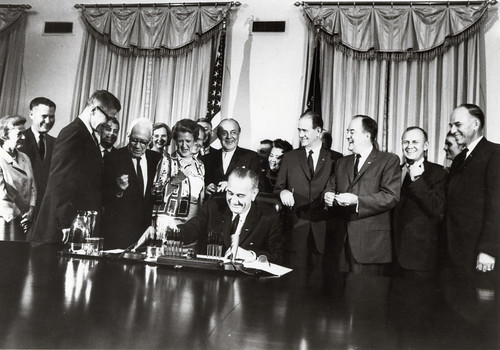
On August 31, 1964, President Johnson signed the Food Stamp Act of 1964 as a centerpiece of his War on Poverty, which introduced numerous programs designed to improve the American quality of life for those struggling to make ends meet. Due to the Food Stamp Act of 1964, the Food Stamp Program, now the Supplemental Nutrition Assistance Program (SNAP), became permanent. This action and others, such as the establishment of the Special Supplemental Program for Women, Infants, and Children (a program celebrating 40 years this year), resulted in marked improvement in the diets of the poor during the late 1960 and into the mid 1970s. Media and public leaders like Robert Kennedy, Senator Robert Dole and Senator George McGovern shone a light on areas of America where hunger and malnutrition had previously been easy to miss, such as crowded urban centers and the tranquil rural countryside, and the programs responded.
Upon signing the Food Stamp Act of 1964, President Johnson said:
“It is one of many sensible and needed steps we have taken to apply the power of America's new abundance to the task of building a better life for every American… .As a permanent program, the food stamp plan will be one of our most valuable weapons for the war on poverty.”
Over the next 10 years, states and counties added the program to the portfolio of services to help low income individuals and their families put healthy food on the table. By October of 1974, the program was nationwide.
Prior to the Food Stamp Act of 1964, the program was a series of pilots that began in 1961 when President Kennedy signed the first Executive Order of his presidency, fulfilling a campaign promise made in West Virginia. In May 1961, Chloe and Alderson Muncy of Paynesville were ceremoniously driven 25 miles to the county seat in Welch, West Virginia where they were given the first $95 in food stamps to help feed themselves and their children. For 6 years, Mrs. Muncy said, food stamps made it possible for her to feed the 13 of her 15 children who were still at home and to keep them in school.
“'It made all the difference…. There wasn't any school lunch then in the one room schools that some of the kids went to. And buying lunch to send off nine of those kids to school every day - we couldn't have done it without the stamps.
Notably though, the history of the program goes back even farther to the late 1930s. Back then, during the height of the Great Depression, the program served not only to provide food to the hungry but also stimulate the economy by encouraging purchase of surplus foods. On May 16, 1939, Mrs. Mabel McFiggan of Rochester, New York was the first recipient who made a purchase using food stamp benefits at a store owned by retailer Joseph Mutolo. At that time, recipients received orange stamps equal to their normal food expenses. For every $1 worth of orange stamps purchased, 50 cents worth of blue stamps were provided. Orange stamps could be used to buy any food, while blue stamps could only be used to buy food designated as a surplus food by the USDA. The surplus program ended in 1943, however, its legacy remains, as even today, the color orange represents commitment to end hunger in America.
For more information on the history of SNAP visit: http://www.fns.usda.gov/snap/short-history-snap.
